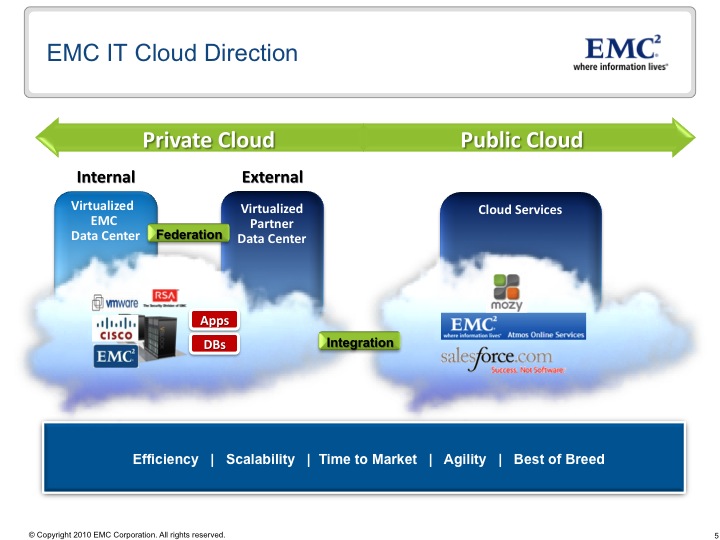A recent comment in our EMC IT Journey blog reminded me of a really good diagram I’d seen our CIO, Sanjay Mirchandani, use in a presentation to describe EMC IT’s view of cloud computing. As I’m sure you’re painfully aware, there are hundreds of definitions for “cloud” being used in our industry. They do, however, share a common theme: new ways of building, operating and consuming IT that’s more flexible, dynamic, efficient, and available on demand. And their common attraction is converting fixed-cost IT infrastructure into variable-cost services.
At EMC, we see pervasive virtualization as a natural, evolutionary way to gain those benefits—and to keep control and choice where they belong: in customers’ hands. We call this approach “Private Cloud.”
Like multi-modal containers that revolutionized the shipping industry, we can use virtualization to move business applications across compatible platforms within—or beyond—the corporate firewall. Now imagine an open market of compatible service providers competing for your business. That’s real choice. But it’s still not enough.
It’s control and choice that drives our distinction between public and private clouds. We ask two simple questions: Who controls the choice of apps, or how they’re built and deployed? Who controls resource allocation, service level management and security? If it’s an external provider, it’s “public.” If it’s the customer, it’s “private”—regardless whether the resources involved are inside or outside the corporate firewall.

As I’ve said in an earlier post, our IT folks wanted to keep things simple. This is where a good picture can definitely be worth a thousand words. So here’s that diagram from Sanjay’s presentation.
First, I’d like to point out that we’re not adhering to any purist doctrine here. Our IT team is mixing the best of public cloud, one example being Salesforce.com, with the private cloud EMC IT is building.
Our IT guys are focusing first on constructing the internal part of EMC’s Private Cloud. When they’re ready, they’ll start federating workloads outside the corporate firewall with compatible external providers.
To be fair, this is a journey for everyone in the service provider market, too. It’s our hope at EMC that our IT organization and service providers will develop compatible Private Cloud capabilities at roughly the same pace. Yes, there’s still technology to be built. But changing business models, processes, and politics present even higher hurdles for all of us to clear.